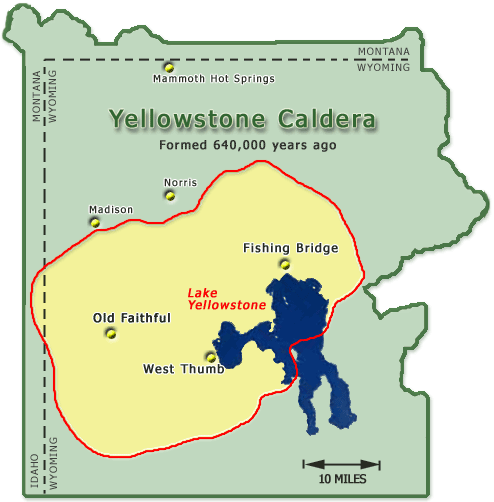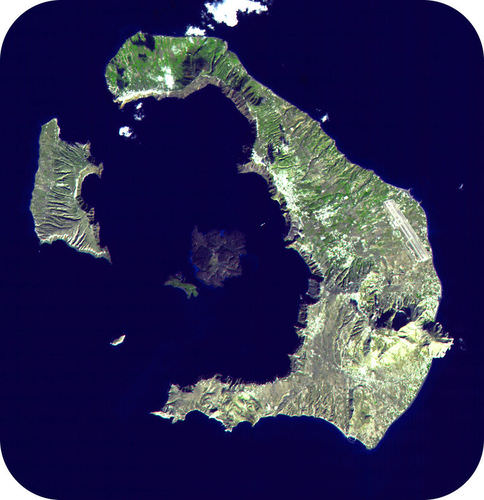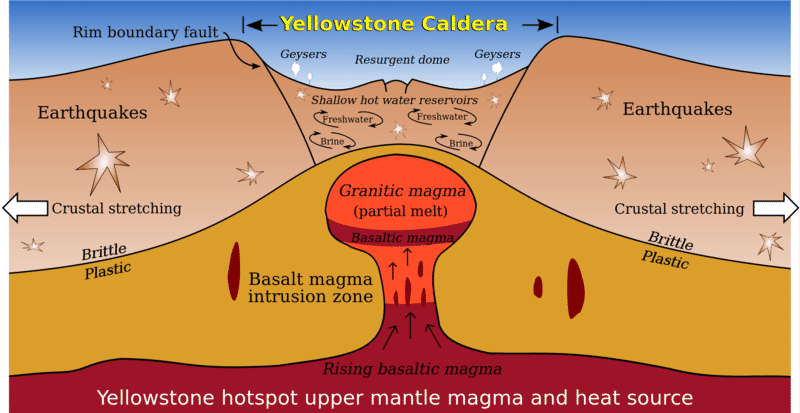READ: Supervolcanoes
READ: Supervolcanoes
What would cause such a giant caldera?
You can stand on the rim and view the enormous Yellowstone Caldera, but it's hard to visualize a volcano or a set of eruptions that enormous. Supervolcanoes are a fairly new idea in volcanology. Although their eruptions are unbelievably massive, they are exceedingly rare. The power of Yellowstone, even 640,000 years after the most recent eruption, is seen in its fantastic geysers.
Supervolcanoes
Supervolcano eruptions are extremely rare in Earth's history. It’s a good thing because they are unimaginably large. A supervolcano must erupt more than 1,000 cubic km (240 cubic miles) of material, compared with 1.2 km3 for Mount St. Helens or 25 km3 for Mount Pinatubo, a large eruption in the Philippines in 1991. Not surprisingly, supervolcanoes are the most dangerous type of volcano.
Supervolcano Eruptions
The exact cause of supervolcano eruptions is still debated. However, scientists think that a very large magma chamber erupts entirely in one catastrophic explosion. This creates a huge hole or caldera into which the surface collapses (figure below).
The caldera at Santorini in Greece is so large that it can only be seen by satellite.
Yellowstone Caldera
The largest supervolcano in North America is beneath Yellowstone National Park in Wyoming. Yellowstone sits above a hotspot that has erupted catastrophically three times: 2.1 million, 1.3 million, and 640,000 years ago. Yellowstone has produced many smaller (but still enormous) eruptions more recently (figure below). Fortunately, current activity at Yellowstone is limited to the region’s famous geysers.
The Yellowstone hotspot has produced enormous felsic eruptions. The Yellowstone caldera collapsed in the most recent super eruption.
Supervolcano Eruptions and Life on Earth
A supervolcano could change life on Earth as we know it. Ash could block sunlight so much that photosynthesis would be reduced and global temperatures would plummet. Volcanic eruptions could have contributed to some of the mass extinctions in our planet’s history. No one knows when the next super eruption will be.
Volcanic Hotspots
Some volcanoes form over active hotspots. Scientists count about 50 hotspots on the Earth. Hotspots lie directly above a column of hot rock called a mantle plume. Mantle plumes continuously bring hot rock up from the mantle toward the crust (figure below). The rock melts due to the release of pressure.
Hotspots Within Oceans
Hotspots are much more common beneath ocean crust. This is because ocean crust is thinner. The plume can more easily penetrate this crust. As the tectonic plates move above a hotspot, they form a chain of volcanoes. The islands of Hawaii formed over a hotspot in the middle of the Pacific plate. The volcanoes are massive shield volcanoes that together create the islands. The lavas are mafic and have low viscosity.
The Hawaii hotspot has been active for tens of millions of years. The volcanoes of the Hawaiian Islands formed at this hotspot. Older volcanoes that formed at the hotspot have eroded below sea level. These are called the Emperor Seamounts.
Loihi seamount is currently active beneath the water southeast of the Big Island of Hawaii. One day, the volcano will rise above sea level. Loihi will join the volcanoes of the island or create a new island (figure below).
A bathymetric map of Loihi seamount. Loihi will be the next shield volcano in the Hawaiian-Emperor chain.
Hotspots Within Continents
Hotspots are found within continents, but not as commonly as within oceans. They are not common because it takes a massive mantle plume to penetrate the thick continental crust. Eruptions from these hotspots are rare but massive. The Yellowstone hotspot is a famous example of a continental hotspot.
Summary
- Supervolcano eruptions are rare but massive and deadly.
- Yellowstone Caldera is a supervolcano that has erupted catastropically three times.
- Supervolcano eruptions can change the course of life on Earth.
- Volcanoes grow above hotspots. A hotspot is a zone of melting above a mantle plume.
- Hotspot volcanoes are better able to penetrate oceanic crust than continental crust. We see many more hotspot volcanoes in the oceans.
- Shield volcanoes commonly form above hotspots in the oceans.




